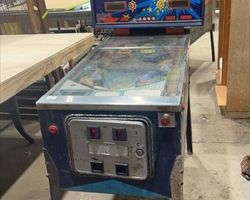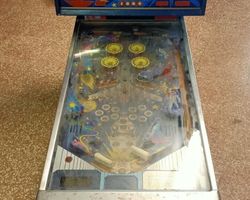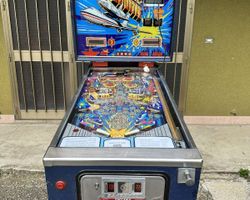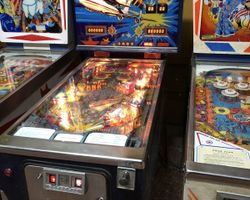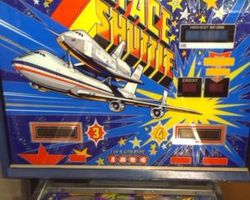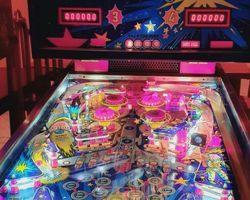Space Shuttle

Average Prices: USD $300 to $700
Produced: September, 1980
Machine Type: Solid State Electronic
MPU: Zaccaria Generation 1
Players: 4
Art by: Lorenzo Rimondini
Zaccaria’s "Space Shuttle," released in January 1980, stands as a notable achievement from the Italian manufacturer during a period when American companies largely dominated the pinball landscape. Emerging amidst a global fascination with space exploration, the machine capitalized on the then-nascent Space Shuttle program, capturing the public’s imagination with a theme of ambition and discovery. This solid-state electronic (SS) game represented Zaccaria's commitment to innovation and quality, aiming to compete directly with established industry titans. The design and production process were guided by an ambition to deliver a compelling gameplay experience, with the artwork crafted by Lorenzo Rimondini, whose vibrant vision infused the machine with its distinctive visual identity. "Space Shuttle" was part of Zaccaria’s Generation 1 of MPU-driven machines, demonstrating their evolving technological capabilities. Its arrival in the market in 1980 marked a significant moment for the company, establishing a benchmark for their future offerings and earning recognition for its sophisticated presentation and engaging play.
Signature Features and Design
"Space Shuttle" distinguishes itself through a fusion of striking aesthetics and well-integrated mechanical elements. The artwork by Lorenzo Rimondini is a major draw, characterized by its bright, vivid, and highly detailed execution. The backglass, in particular, captures attention with its depiction of the Enterprise Space Shuttle atop a Boeing 747 carrier aircraft, alongside a prominently featured astronaut, embodying the era's spacefaring optimism. This thematic consistency extends across the playfield and cabinet, creating a cohesive visual narrative that is both immersive and captivating.
Beyond its visual appeal, the machine incorporates a range of physical features that define its gameplay. It includes two flippers, positioned at the bottom of the playfield for primary ball control. Four pop bumpers are strategically placed to create dynamic ball movement and score accumulation. The playfield is further populated by a total of nine drop targets, arranged in three distinct banks. Two kick-out holes offer opportunities for skill shots, with one notably protected by a set of in-line drop targets in the left lane, adding a layer of challenge. A single spinning target provides another interactive element, reacting to ball strikes with satisfying rotation. The machine utilizes a digital display for score tracking, a standard for solid-state games of its time, providing clear and immediate feedback to players. These components are not merely decorative but are integral to the game’s core mechanics, contributing directly to its flow and player interaction.
Playfield and Mechanics
The playfield layout of "Space Shuttle" is meticulously crafted, praised for its efficiency and intuitive design, where every shot serves a purpose. The general flow encourages players to manage the ball efficiently through a series of targets and lanes to maximize their scoring potential. Starting from the lower playfield, accurate shots from the flippers are crucial for navigating the various scoring opportunities. The four pop bumpers, positioned to keep the ball active and generate points, are central to building the bonus multiplier.
Ascending the playfield, a prominent left lane serves a strategic function: sending the ball up to activate the spinner located on the right side of the playfield. Striking the spinner repeatedly is key, as it leads directly to a bank of "Bonus X" drop targets positioned in the upper left, essential for multiplying end-of-ball bonuses. Above the pop bumpers, additional lanes are designed to drop middle targets when lit, providing further score opportunities and progression.
The playfield also features multiple banks of drop targets, requiring precise shooting to clear them. A set of in-line drop targets guard one of the two kick-out holes, demanding accuracy to access its rewards. Critically, hitting a specific set of middle playfield drop target banks illuminates the top saucer, which then flashes for a "Blast Off/Special" award. This feature is visually enhanced by flickering inserts in the middle of the playfield, designed to simulate engine firing stages, adding to the theme's immersion. The exit from the top left lane is engineered to return the ball gracefully between the flippers, maintaining game flow and setting up subsequent shots. This comprehensive layout, combined with vibrant artwork and responsive lighting, contributes to a stimulating and coherent play experience.
Gameplay Dynamics
The gameplay of "Space Shuttle" centers around a well-defined and engaging ruleset: "build bonus and collect bonus." This core mechanic is executed with precision, providing a satisfying progression that is easy for newcomers to grasp yet offers depth for experienced players seeking mastery. The primary objective is to accumulate bonus points and increase the bonus multiplier before the ball drains.
Gameplay begins by using the manual plunger to launch the ball onto the playfield. The initial focus often shifts to activating the spinner by sending the ball up the left lane. Consistent hits on the spinning target are then critical for advancing the "Bonus X" drop targets in the upper left, directly multiplying the bonus accumulated throughout the ball. Pop bumpers are highly effective in rapidly building the base bonus score, with their rapid-fire action contributing significantly to point accumulation.
Strategic play involves targeting the various banks of drop targets. Dropping the middle playfield target banks is essential for activating the "Blast Off/Special" feature. Once these targets are cleared, the top saucer becomes lit and flashes, inviting players to hit it for a substantial point award, visually confirmed by the "engine firing" flickering inserts. This sequence creates a palpable sense of excitement and accomplishment. The challenge lies not just in hitting individual targets, but in chaining shots together to maintain ball control and maximize bonus progression. The game rewards consistent play, precise aiming, and a clear understanding of its distinct objectives, fostering a play experience that players often describe as both accessible and deeply rewarding.
Reception and Legacy
Zaccaria’s "Space Shuttle" garnered overwhelmingly positive feedback from the pinball community, solidifying its place as a standout machine from its era. Players consistently praised its design, often describing it as an "utterly brilliant and fantastic" game that compelled them to return for repeated plays. A significant strength noted was Lorenzo Rimondini’s artwork, which was lauded for its brightness, vibrancy, and detail across the backglass, playfield, and cabinet, creating a visually appealing and thematically cohesive experience. The playfield layout itself received high acclaim, described as "top-notch" with no wasted shots, indicating a design where all elements harmoniously contributed to the gameplay.
The machine's ruleset, centered on building and collecting bonuses, was particularly well-received for its excellent execution. It struck a balance between being "easy to learn but hard to master," appealing to a broad spectrum of players. Specific gameplay mechanics, such as the interaction between the left lane, the spinner, and the "Bonus X" drops, along with the captivating "Blast Off/Special" feature signaled by flickering engine stage inserts, were highlighted as compelling elements that enhanced the overall experience. Many enthusiasts considered "Space Shuttle" to rival, and in some aspects surpass, contemporary machines from leading American manufacturers like Williams and Bally, including titles such as "Firepower" and "Black Knight." This sentiment underscored Zaccaria’s capability to produce high-quality, competitive pinball machines.
Despite its many strengths, "Space Shuttle" presented a few challenges. The Italian rule sheets proved to be a barrier for English-speaking players, leading to requests for translations to fully understand game nuances. The sound package, while fitting the theme, was noted as being similar to "stock Williams" sounds, sometimes causing players to initially mistake its manufacturer. More significantly, the machine’s availability became a considerable hurdle; it is recognized as very difficult to find for sale, and acquiring replacement parts is described as an arduous, often "impossible" task. These factors contribute to its rarity and sought-after status among collectors. "Space Shuttle" remains highly regarded, its reputation built on a strong, engaging gameplay foundation and distinctive visual appeal, marking it as a significant achievement in Zaccaria’s production history.
Sponsored Links
 Ebay Listings
Ebay Listings
 Auction Results
Auction Results
| Cost | Location | Date |
|---|---|---|
| EUR €500 |  Italy Italy |
09 January, 2025 |
| AUD $950 |  Victoria, Australia Victoria, Australia |
23 July, 2023 |
| EUR €1,400 |  Italy Italy |
23 May, 2023 |
| EUR €1,680 |  Italy Italy |
16 April, 2023 |
| EUR €2,800 |  Rheinland-Pfalz, Germany Rheinland-Pfalz, Germany |
14 November, 2021 |
| GBP £950 |  Leamington Spa, United Kingdom Leamington Spa, United Kingdom |
06 October, 2019 |
| GBP £950 |  Leamington Spa, United Kingdom Leamington Spa, United Kingdom |
23 September, 2019 |
| GBP £609 |  United Kingdom United Kingdom |
18 April, 2019 |
| GBP £630 |  United Kingdom United Kingdom |
20 August, 2018 |
| EUR €999 |  Italy Italy |
03 May, 2017 |


Private Policy · Search Website · Contact Us
As an eBay Partner, we may earn a commission from qualifying purchases made through links on this site, at no additional cost to you.
All trademarks and copyrighted materials remain property of their respective owners. All other content copyright 2007 - 2025 Pinpedia.

